Immerse yourself in the rhythmic beauty of Laos traditional dance, from the elegant Lam Vong to the epic Phra Lak Phra Lam. Discover the history, styles, and cultural significance of these captivating performances in this Laos travel guide for 2025, perfect for travelers seeking authentic cultural experiences.
Laos, a serene jewel in Southeast Asia, is renowned for its tranquil landscapes and profound cultural heritage. At the heart of this heritage lies Laos traditional dance, a vibrant art form that weaves together the nation’s history, spirituality, and ethnic diversity. From the communal circles of Lam Vong dance to the intricate storytelling of Laos classical dance, these performances embody the soul of Laotian dance culture. Performed at festivals, weddings, and sacred ceremonies, Laos folk dance and classical styles reflect the traditions of the country’s 49 ethnic groups, including the Lao Loum, Hmong, and Khmu. For travelers having tours to Vietnam Cambodia and Laos in 2025, experiencing Laos dance performances offers a window into the nation’s rich Laos cultural heritage. Here’s everything you need to know about Laos traditional dance, its styles, and where to witness its magic.
Historical Roots – The Evolution of Laos Traditional Dance
Laos traditional dance has deep roots in the country’s history, shaped by Theravada Buddhism, animist beliefs, and influences from neighboring Thailand, Cambodia, and India. According to the Traditional Arts and Ethnology Centre (TAEC), dance in Laos dates back centuries, evolving from ritualistic performances to entertain royalty and honor deities. The royal courts of Luang Prabang developed Laos classical dance, known as Fon Nang Keo, which drew inspiration from the Indian Ramayana epic, particularly the Lao version, Phra Lak Phra Lam. These performances, reserved for kings, featured intricate gestures and elaborate costumes.
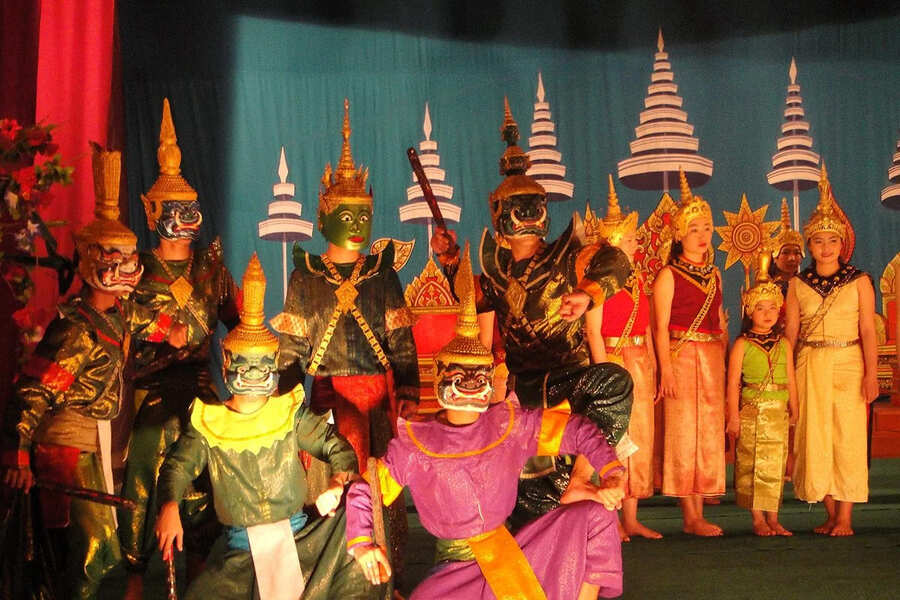
Meanwhile, Laos folk dance emerged among rural communities, reflecting daily life, harvest celebrations, and ethnic traditions. The Lam Vong, a circular folk dance, became a communal expression of joy, uniting villagers during festivals. The decline of the monarchy in 1975 shifted focus to folk dances, which gained prominence for their accessibility and cultural significance. Today, Laotian dance culture thrives in both traditional and modern contexts, preserving ancient techniques while embracing contemporary influences.
Travel Tip: Visit the TAEC in Luang Prabang to explore exhibits on Laos cultural heritage, including dance costumes and historical artifacts, for a deeper understanding of Laos traditional dance.
Lam Vong – The Heartbeat of Laos Folk Dance
The Lam Vong dance is the most iconic of Laos folk dances, a lively circular performance that symbolizes unity and celebration. Translating to “circle dance,” Lam Vong involves pairs of men and women moving gracefully in concentric circles, accompanied by traditional instruments like the khaen (bamboo mouth organ) and mor lam (folk singing). According to Tourism Laos, the dance originated among the Lao Loum, the majority ethnic group, and is performed at weddings, festivals, and community gatherings, such as Pi Mai (Lao New Year) in April.
Dancers wear traditional attire—women in silk Sinh skirts with gold-embroidered hems, and men in Salong pants—enhancing the visual splendor. The movements are slow and deliberate, with women’s hands forming lotus-like gestures and men responding with subtle steps. The Lam Vong is inclusive, inviting participants of all ages to join, making it a quintessential expression of Laotian dance culture.
Travel Tip: Experience Lam Vong dance at the Night Market in Luang Prabang, where local troupes perform during festivals. Join in respectfully to connect with locals and embrace Laos festival dances.
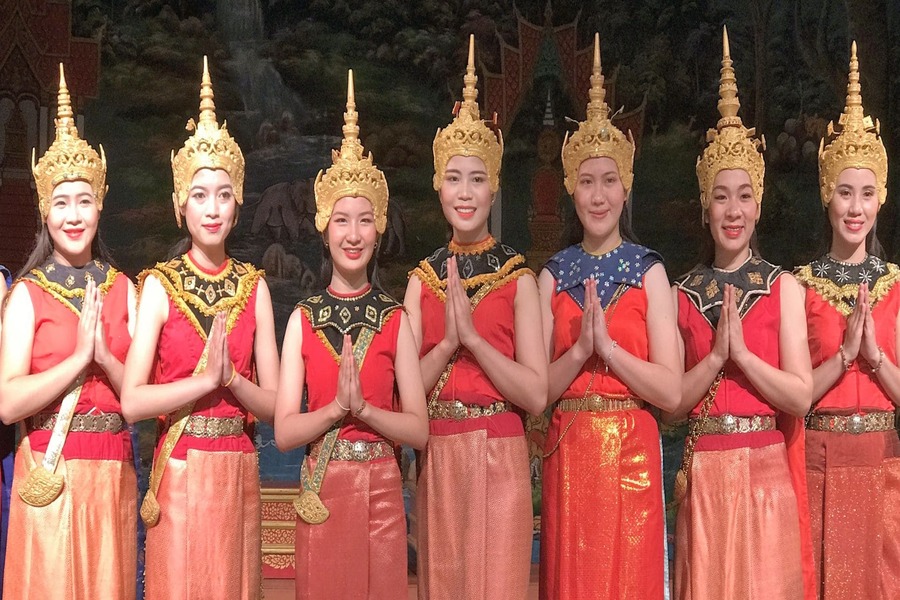
Phra Lak Phra Lam – The Epic Laos Classical Dance
Phra Lak Phra Lam, the Lao adaptation of the Ramayana, is the pinnacle of Laos classical dance, performed as a dance-drama by the Royal Lao Ballet. This epic narrative, depicting the love story of Prince Rama (Phra Lam) and Princess Sita (Nang Sida), is brought to life through precise hand gestures, expressive facial movements, and ornate costumes. As noted by the Lao Handicraft Association, the dance requires years of training, with performers wearing gilded headdresses, silk robes, and masks for animal characters like Hanuman, the monkey warrior.
Historically performed for royalty at Wat Xieng Thong, Phra Lak Phra Lam is now staged at cultural venues like the National Theatre in Vientiane during major festivals, such as Boun Ok Phansa. The accompanying orchestra, featuring drums, xylophones, and khaen, adds a rhythmic depth that elevates the storytelling, making it a must-see Laos dance performance.
Travel Tip: Book tickets for a Phra Lak Phra Lam performance at the Royal Palace Museum in Luang Prabang (~$10–20). Arrive early for front-row seats to appreciate the intricate movements of this Laos classical dance.
Fon Phu Thai – Ethnic Diversity in Laos Traditional Dance
The Fon Phu Thai, a traditional dance of the Phu Thai ethnic group in central and northeastern Laos, showcases the diversity of Laos ethnic dances. Performed during festivals and rituals, this dance features women in colorful, handwoven skirts and men in traditional vests, moving to the hypnotic rhythms of bamboo flutes and drums. According to cultural sources, the Fon Phu Thai often depicts themes of harvest, courtship, or spiritual offerings, with fluid arm movements mimicking nature, such as flowing rivers or swaying rice fields.
The dance is prevalent in Savannakhet and Khammouane provinces, where Phu Thai communities maintain their traditions through village performances. Its vibrant energy and cultural specificity make it a highlight of Laos folk dance.
Travel Tip: Visit Savannakhet during the Lao New Year to see Fon Phu Thai performances at local temples. Engage with Phu Thai communities through guided cultural tours to learn about their Laos cultural heritage.
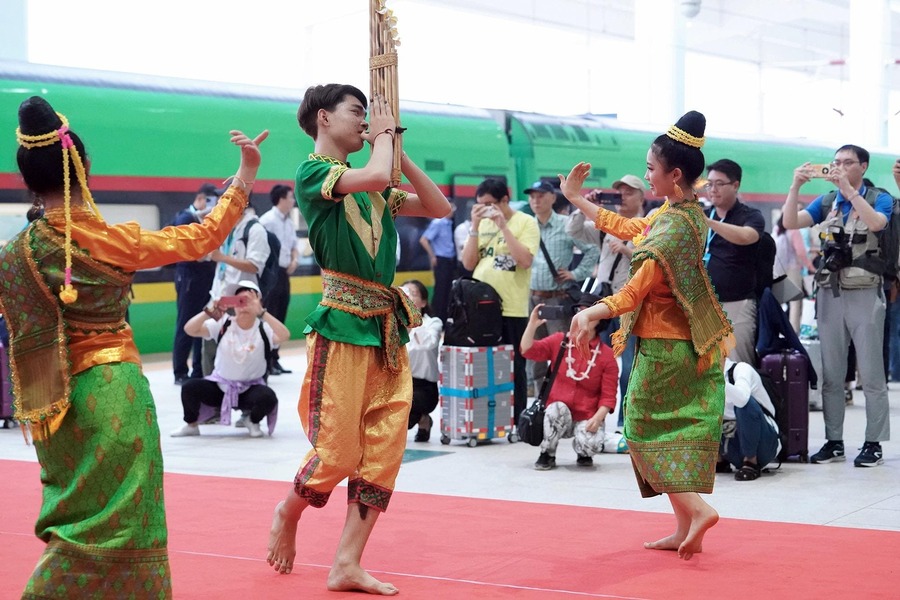
Baci Ceremony Dance – Spiritual Laos Traditional Dance
The Baci ceremony dance, performed during the traditional Lao Baci (soul-calling) ritual, is a sacred expression of Laos spiritual practices integrated into Laos traditional dance. The Baci ceremony, rooted in animist and Buddhist beliefs, celebrates life events like births, weddings, or farewells, invoking the 32 khwan (spirits) of the body to ensure harmony. Dancers, typically women in elegant Sinh skirts, perform gentle, synchronized movements around a pha khuan (ceremonial tray) adorned with flowers and candles, accompanied by chanting and mor lam singing.
The dance’s fluid gestures, such as hand rotations symbolizing unity, create a meditative atmosphere, inviting guests to tie white strings on participants’ wrists for blessings. As noted by golaos.tours, the Baci ceremony dance is a common feature at cultural events in Vientiane and Luang Prabang, offering travelers a spiritual connection to Laotian dance culture.
Travel Tip: Participate in a Baci ceremony dance at Ock Pop Tok’s Living Crafts Centre in Luang Prabang (~$20–30, including workshop). Dress modestly and follow local guidance to respect this sacred Laos traditional dance.
Costumes and Music – Enhancing Laos Dance Performances
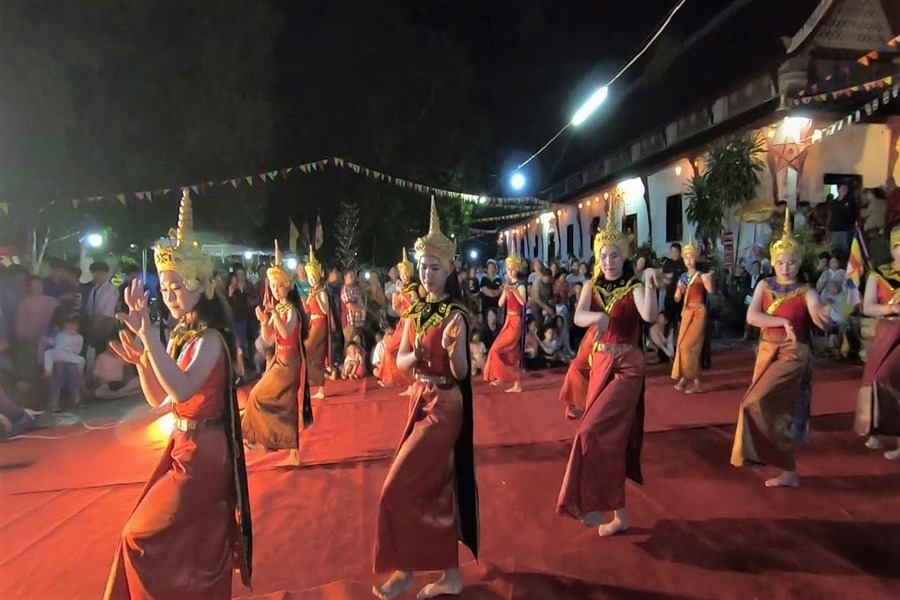
The visual and auditory elements of Laos traditional dance are inseparable from its movements, with costumes and music elevating every performance. Women dancers wear Sinh skirts with intricate gold or silver embroidery, paired with silk blouses and shawls, while men don Salong pants or tailored jackets, as described by the Lao Handicraft Association. Classical dancers, especially in Phra Lak Phra Lam, wear gilded headdresses and jewelry, reflecting royal heritage, while folk dancers opt for vibrant, handwoven textiles specific to their ethnic group.
Music is provided by traditional ensembles, including the khaen, drums (kong), xylophones (ra nat), and stringed instruments like the phin. Mor lam singers add narrative depth, particularly in folk dances like Lam Vong and Fon Phu Thai, weaving stories of love or harvest. These elements create a multisensory experience, making Laos dance performances a highlight of any cultural journey.
Travel Tip: Shop for authentic Sinh and Salong costumes at the Morning Market in Vientiane to support local weavers. Attend a performance at Wat Sene in Luang Prabang to hear the khaen in action during Laos festival dances.
Where to Experience Laos Traditional Dance
Laos traditional dance comes alive at festivals, temples, and cultural venues across the country, offering travelers countless opportunities to witness its beauty. Major events like Pi Mai (April) and Boun Ok Phansa (October) feature Lam Vong and Fon Phu Thai performances in Luang Prabang and Vientiane, with temples like Wat Xieng Thong hosting Phra Lak Phra Lam shows. The That Luang Festival in November showcases a mix of folk and classical dances, blending spirituality with celebration.
Cultural centers like Ock Pop Tok and the Traditional Arts and Ethnology Centre offer workshops and performances, while restaurants like Lao Kitchen in Vientiane pair dinner with Lam Vong shows. Rural areas, such as Savannakhet or Nong Khiaw, provide authentic village performances, especially during ethnic festivals. Tickets for major shows range from $10–30, while temple performances are often free with a small donation (5,000–20,000 kip).
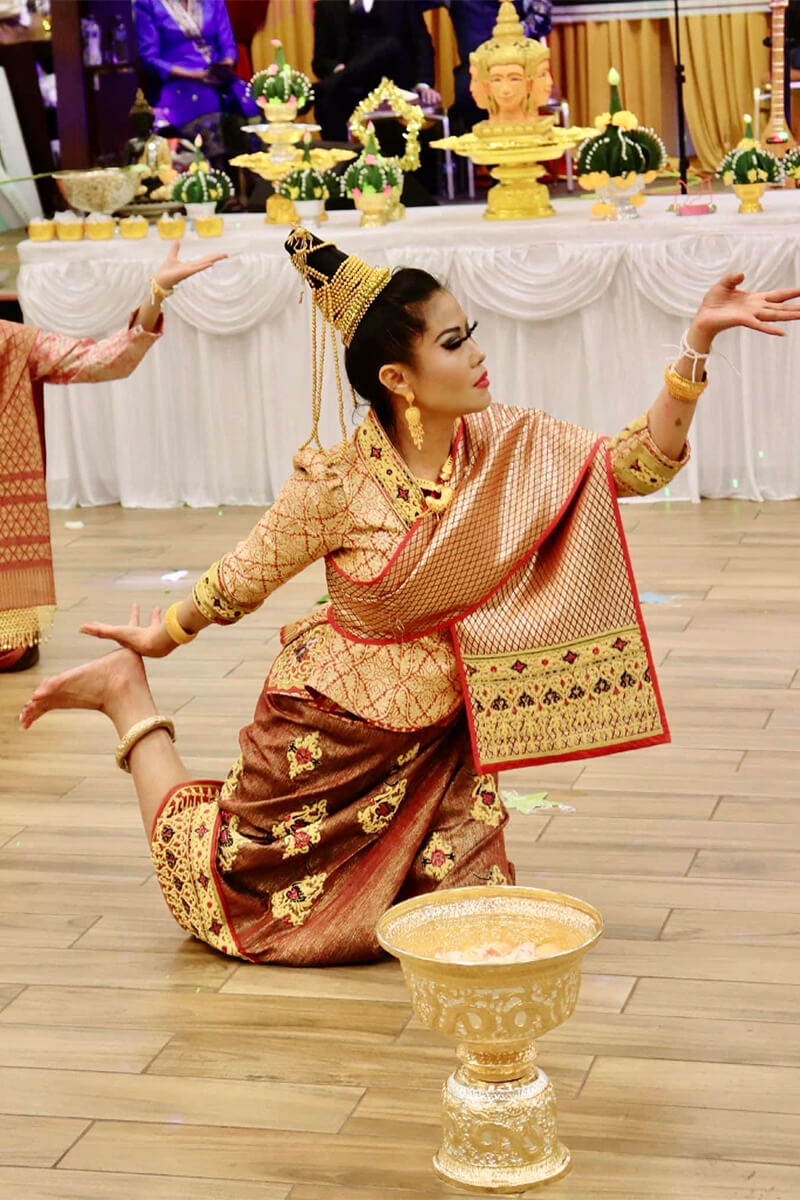
Travel Tip: Plan your visit during Pi Mai in Luang Prabang to see Laos festival dances at their peak. Book a cultural tour with Green Discovery Laos (~$50–100) to experience Laos ethnic dances in remote villages, ensuring respectful engagement.
Embracing Laos Traditional Dance as a Traveler
Laos traditional dance is a vibrant thread in the nation’s cultural tapestry, weaving together Buddhist spirituality, ethnic diversity, and communal joy. From the inclusive Lam Vong dance to the majestic Phra Lak Phra Lam, these performances offer travelers a profound connection to Laotian dance culture. Whether you’re joining a Baci ceremony dance or watching Fon Phu Thai in a village, each experience reveals the heart of Laos cultural heritage.
To fully immerse yourself, visit cultural hubs like Luang Prabang, Vientiane, or Savannakhet, where dance performances are accessible year-round. Respect local customs by dressing modestly (covering shoulders and knees) and asking permission before photographing performances, especially during sacred rituals. For a hands-on experience, join a dance workshop at Lao National Theatre (~$20) or a Baci ceremony to learn basic movements. The dry season (November–April) is ideal for travel, offering clear weather for outdoor festivals and performances.
Pro Tip: Start your cultural journey in Luang Prabang, a UNESCO World Heritage Site, and combine Laos dance performances with visits to temples like Wat Xieng Thong or natural wonders like Kuang Si Waterfall for a complete Laos travel guide 2025 adventure.By embracing the rhythm and grace of Laos traditional dance, you’ll discover the soul of this enchanting land, where every step tells a story of tradition and unity.

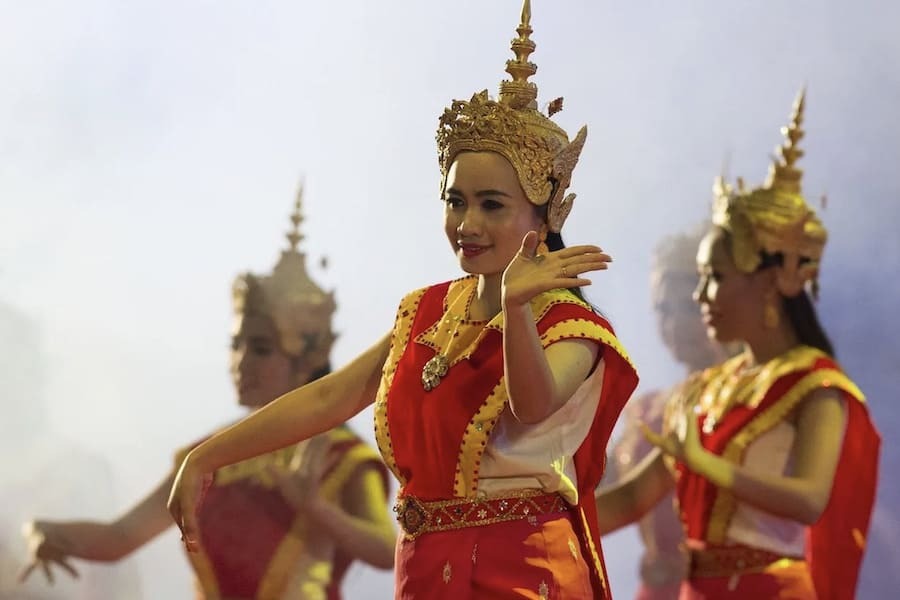
0 Comment